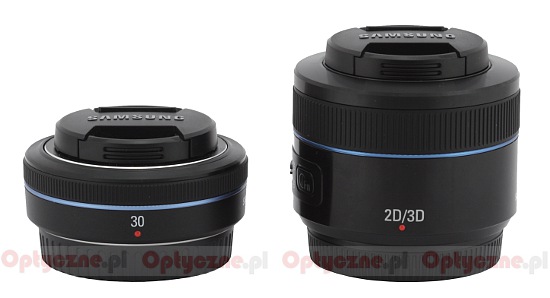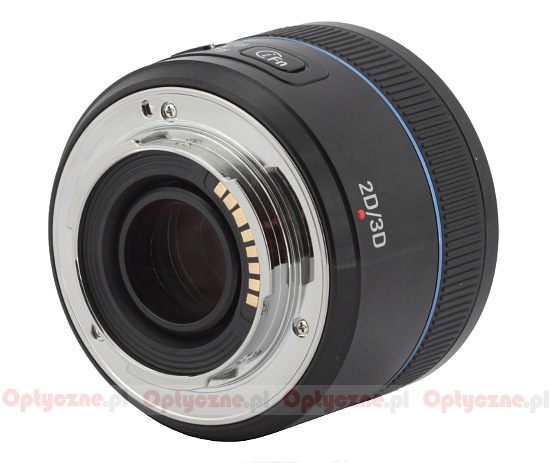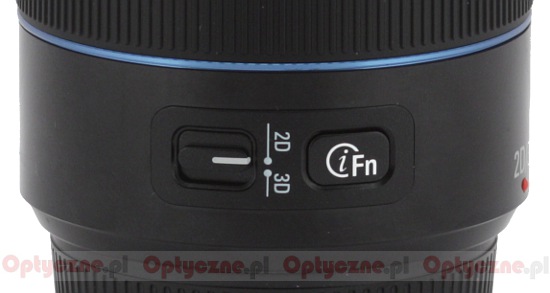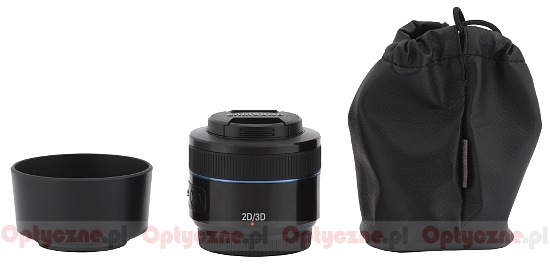Samsung NX 45 mm f/1.8 2D/3D
3. Build quality
The Samsung NX 45 mm f/1.8 2D/3D, although not big, can be hardly called a typical „pancake” lens either. The photo below presents it next to a system 2/30 “pancake” so you can compare their dimensions.
 |
Please Support UsIf you enjoy our reviews and articles, and you want us to continue our work please, support our website by donating through PayPal. The funds are going to be used for paying our editorial team, renting servers, and equipping our testing studio; only that way we will be able to continue providing you interesting content for free. |
- - - - - - - - - - - - - - - - - - - - - - - - - - - - - - - - - - - - - - - - - - - - - - - -
The tested lens starts with a metal bayonet mount which surrounds contacts and a rear element, 20 mm in diameter. The element seems to be immobile. Between its edge and the body of the lens there are no big slits or gaps through which you would glimpse the inner construction parts or electronics.
 |
The proper body of the lens starts with a very narrow ring made of metal which pretty soon gets wider. Further on it is covered by black plastics. Looking from above you can find an inscription “2D/3D” on it, the word “Samsung” on the right and the i-Function button (which you can attribute the change of such parameters as e.g. aperture, time of exposure or ISO value). Under the i-Function button there is also a 2D/3D switch allowing you to choose between normal photos and 3D photos.
 |
The next part of the body is a narrow blue ring behind which you can find a manual focus ring. The manual focus ring is 12 mm wide and its work is based on electronic transmission. The working range is quite big because running through the whole distance scale you need a turn through 180 degrees.
Behind the ring you can find another narrow, immobile part of the barrel which turns into a non-rotating filter thread, 43 mm in diameter. The front element of the tested instrument, with a diameter of 24 mm, doesn’t move and is surrounded by an inscription with the name and the parameters of the lens.
The optical construction of the lens consists of 7 elements positioned in 6 groups. Inside you can also find a circular aperture with nine diaphragm blades which can be closed down to a value of f/22.
Buyers get both caps, a hood and a soft pouch in the box.
 |
3D function
As the name itself indicates the lens allows you to take 3D photos but, already at the very beginning, we must mention the limitations of that mode. First of all, currently the only camera which allows you to get 3D photos is the Samsung NX300. Older models, even with the latest, upgraded versions of software, don’t react and, no matter what position the 2D/3D switch is, they always take ordinary photos.
The resolution limitation is another matter. In the 3D mode the saved photos have a resolution of just 4 Mpix. What’s more the 3D effect is created by inserting a liquid crystal aperture (which is square with rounded corners) into the axis of the lens which divides the optical field into two parts. For obvious reasons the amount of gathered light diminishes and the camera reacts automatically, limiting the available apertures to f/4.0 and f/6.0.
Once again it has consequences visible in 3D photos. The non-circular cross-section of the 3D aperture can be noticed in defocused images and the frame is unevenly lit as the light is gathered once on the left once on the right side of the optical axis; that, in turn, influences vignetting, clearly visible in animated GIF images, presented below. It should be noticed, though, that when the images are displayed on a 3D TV set that effect is rather imperceptible, definitely less unnerving as in the animations below.
 |
 |






